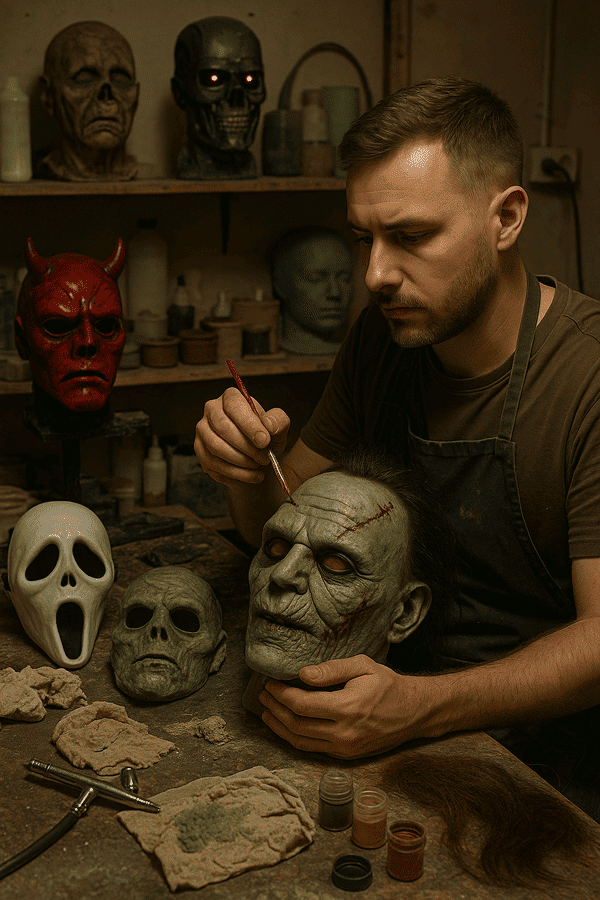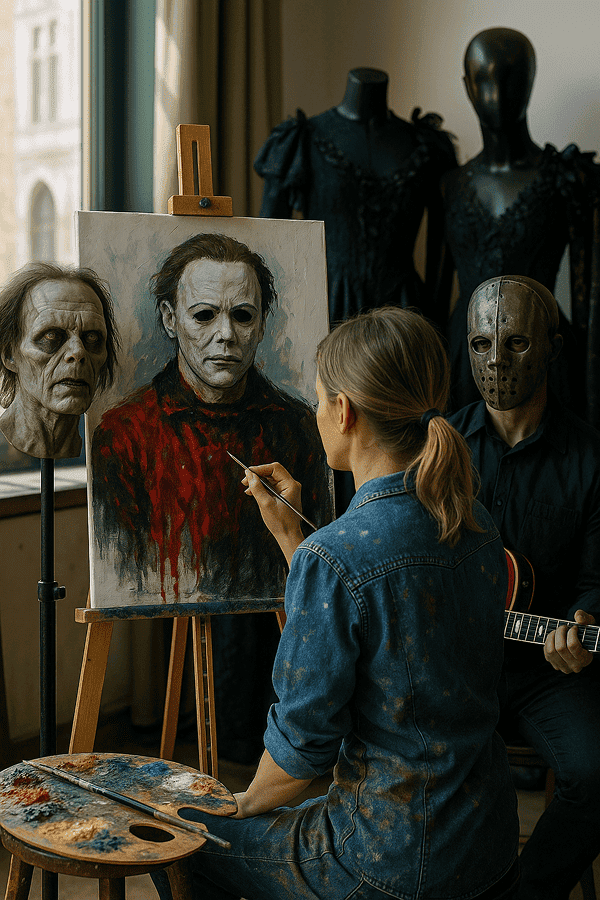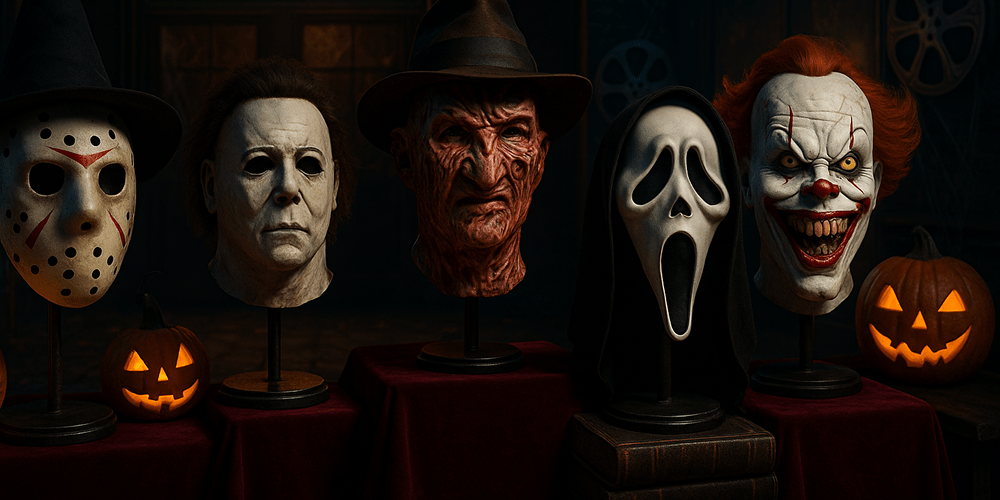Halloween Movie Character Masks are among the most recognizable and sought-after costume accessories during the Halloween season. These masks allow wearers to embody iconic villains, heroes, and creatures from the silver screen—bringing the fantasy and horror of film directly into real-life celebrations. With features that range from the chillingly simple (a blank, expressionless face) to the grotesquely realistic (scars, fangs, and intricate textures), Movie Character Masks capture the essence of beloved or feared cinematic personas. Most popular in North America and Europe since the mid-20th century, these masks have become a staple at Halloween parties, haunted houses, and pop culture conventions. For collectors and enthusiasts, toddmasks.com offers galleries and resources on movie masks and related designs, including Witch and Wizard Masks, which often share a similar appeal.
Historical Origins of Halloween Movie Character Masks
The fascination with movie character masks emerged alongside the rise of the horror and fantasy film genres in the early 20th century. The word “mask” stems from the Latin “masca,” meaning ghost or specter, while “movie character” refers to the personas immortalized by film. The first mass-produced Halloween masks appeared in the 1930s and 1940s, inspired by classic Universal Monsters such as Dracula, Frankenstein’s Monster, The Mummy, and The Wolfman. Companies like Don Post Studios pioneered latex mask production, making it possible for fans to become their favorite movie monsters.
As horror and fantasy cinema flourished, so did the diversity of masks—ranging from the chilling Michael Myers mask in “Halloween” (1978) to the hockey mask of Jason Voorhees in “Friday the 13th,” and the terrifying visage of Ghostface in “Scream.” Over time, advances in sculpting, molding, and painting allowed for increasingly realistic and detailed masks, turning them into both costume essentials and collectible artworks. Today, Halloween Movie Character Masks are inspired by a vast range of genres, from science fiction and superheroes to anime and animation.
Cultural Significance and Symbolism of Halloween Movie Character Masks
Movie Character Masks for Halloween hold a unique place in popular culture. They symbolize the power of transformation, fandom, and communal storytelling. Wearing a mask of a beloved or feared character allows individuals to step into another identity, relive cinematic moments, and explore themes of fear, morality, or fantasy.
Spiritually, these masks echo humanity’s age-old fascination with disguise, role-play, and the supernatural. In a Halloween context, masks serve as tools for catharsis, humor, and shared cultural experience. Myths and legends surrounding movie characters—whether based on ancient folklore or modern mythmaking—are kept alive through the ritual of masking. Socially, these masks unite fans, bridge generations, and foster creativity in costume design and performance.
Materials and Crafting Techniques of Halloween Movie Character Masks
The creation of Halloween Movie Character Masks involves both traditional and modern materials and techniques:
- Materials: Latex, silicone, vinyl, plastic, resin, fabric, and synthetic hair.
- Process: Begins with sculpting a clay or digital model, creating a mold, and casting in the chosen material. The mask is then trimmed, painted, airbrushed, and detailed with features like scars, hair, and accessories.
- Techniques: Hand-painting, airbrushing, silicone skin application, embedded LEDs, and animatronics for special effects.
- Regional differences: American masks focus on Hollywood horror and fantasy icons, while Japanese and European masks may reflect anime, manga, or local movie monsters.
- Color symbolism: Red for violence or passion, black for darkness, white for innocence or terror, and green or gray for the undead or monstrous.

High-end masks may be custom-made by special effects artists, while affordable versions are mass-produced for the costume market. Find more about mask-making and behind-the-scenes insights at toddmasks.com.
Functions and Uses of Halloween Movie Character Masks
These masks have a wide range of uses:
- Ritual and ceremonial: Central to Halloween’s tradition of disguise and role-play.
- Theatrical and performance: Essential in haunted attractions, stage shows, and movie-themed events.
- Festivals and parties: Worn by trick-or-treaters, cosplayers, and parade participants.
- Contemporary uses: Featured in fan conventions, viral social media content, art installations, and photo shoots.
The function of these masks has shifted from simple costume play to include performance art, social commentary, and fan art.
Regional Variations of Halloween Movie Character Masks
Regional styles reflect both global pop culture and local tastes:
- United States and Canada: Emphasis on Hollywood horror and slasher films (Michael Myers, Jason, Freddy Krueger, Chucky).
- Europe: Mix of American icons and British/European horror (Hammer Films, Doctor Who villains).
- Japan: Anime and manga characters, kaiju (Godzilla), and horror icons (Sadako, Kayako).
- Latin America: Incorporate telenovela villains, lucha libre wrestlers, and adapted horror characters.
Each region adapts mask designs to local legends, pop culture, and artistic preferences, making the world of movie character masks diverse and dynamic.
Famous Examples and Notable Collections of Movie Character Masks
Some of the most famous Halloween Movie Character Masks include:
- Michael Myers (“Halloween”) — blank white mask, iconic in horror history.
- Jason Voorhees (“Friday the 13th”) — hockey mask, instantly recognizable.
- Ghostface (“Scream”) — stylized, ghoulish face, a modern classic.
- Freddy Krueger (“A Nightmare on Elm Street”) — burned visage with signature fedora.
- Pennywise (“It”) — clown mask with terrifying makeup and features.
These masks are often displayed in museums such as the Museum of Pop Culture (MoPOP, Seattle), The Hollywood Museum (Los Angeles), and private collections. Artist-signed or screen-used masks are highly prized among collectors. Digital galleries and expert guides are available at toddmasks.com.
Influence of Halloween Movie Character Masks on Art and Culture
Movie Character Masks have had a profound effect on art, design, literature, and music. Their imagery inspires painters, sculptors, make-up artists, and costume designers. In literature and cinema, masks symbolize the tension between appearance and reality, heroism and monstrosity.
In fashion, masks from movies influence runway looks and Halloween collections. Musicians and performers use cinematic masks to create stage personas and visual drama. The preservation and celebration of movie mask culture help maintain a living connection to film history and creative innovation.

Contemporary Status and Preservation of the Movie Mask Tradition
The tradition of making and wearing Movie Character Masks is more vibrant than ever. Master mask-makers and fans use 3D printing, digital sculpting, and eco-friendly materials to create detailed replicas and original designs. Conventions, workshops, and online tutorials keep skills alive and encourage new generations of mask artists.
Museums, film studios, and online communities like toddmasks.com play a key role in preserving, documenting, and celebrating movie mask history. Innovations include smart masks (with sound or lights), augmented reality filters, and collaborations with special effects studios.
Collecting and Acquiring Halloween Movie Character Masks
The collector’s market for Movie Character Masks ranges from affordable mass-market versions to rare, artist-signed, or screen-used originals. Authentic masks can be found at costume shops, conventions, auctions, and online platforms such as toddmasks.com. Factors affecting value include:
- Material and craftsmanship
- Association with famous films or actors
- Limited editions, artist signatures, or certificates of authenticity
- Rarity and provenance
Collectors should support original artists, avoid counterfeits, and seek documentation for high-value pieces.
